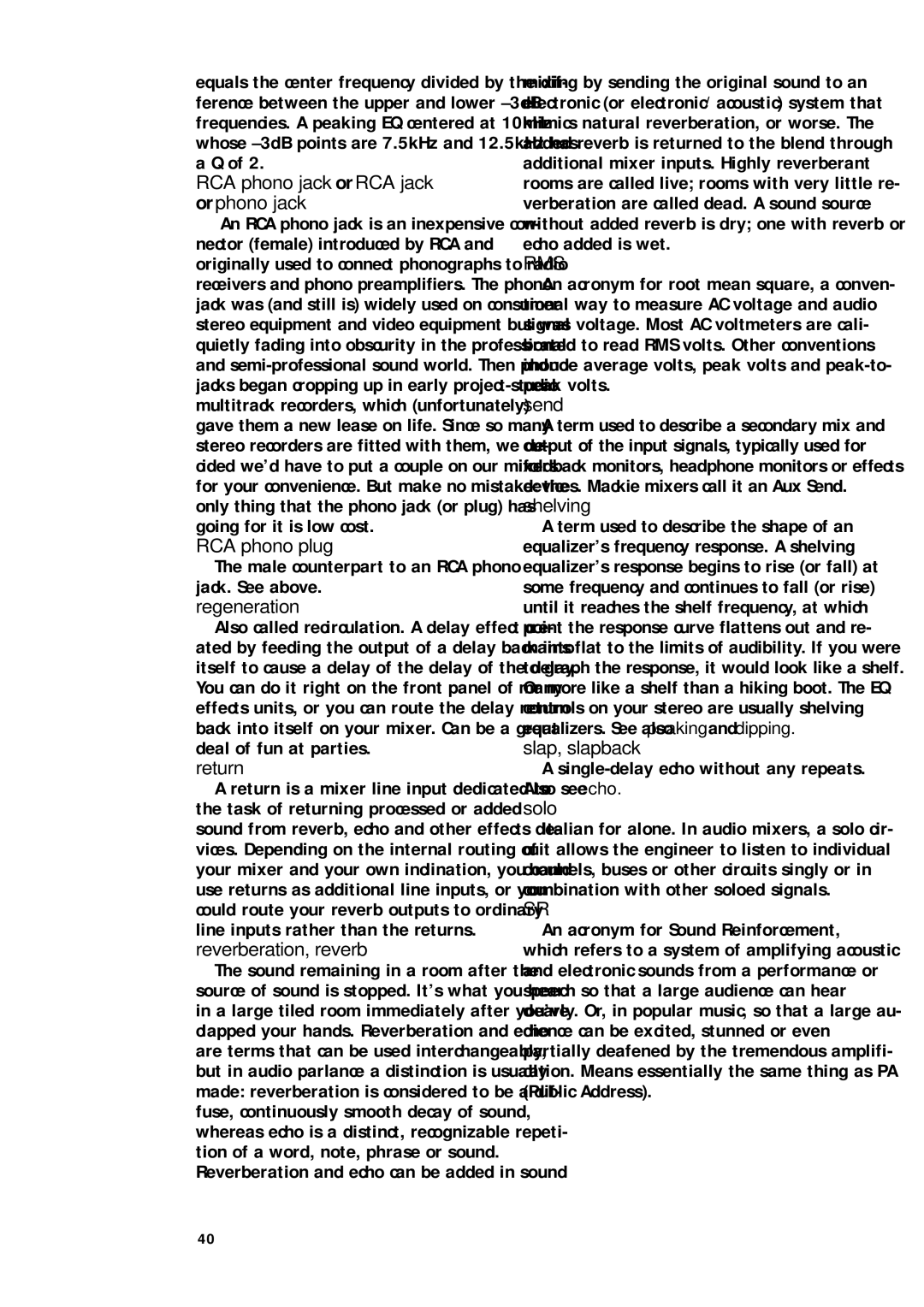equals the center frequency divided by the dif- ference between the upper and lower
RCA phono jack—or RCA jack or phono jack
An RCA phono jack is an inexpensive con- nector (female) introduced by RCA and originally used to connect phonographs to radio receivers and phono preamplifiers. The phono jack was (and still is) widely used on consumer stereo equipment and video equipment but was quietly fading into obscurity in the professional and
RCA phono plug
The male counterpart to an RCA phono jack. See above.
regeneration
Also called recirculation. A delay effect cre- ated by feeding the output of a delay back into itself to cause a delay of the delay of the delay. You can do it right on the front panel of many effects units, or you can route the delay return back into itself on your mixer. Can be a great deal of fun at parties.
return
A return is a mixer line input dedicated to the task of returning processed or added sound from reverb, echo and other effects de- vices. Depending on the internal routing of your mixer and your own inclination, you could use returns as additional line inputs, or you could route your reverb outputs to ordinary line inputs rather than the returns.
reverberation, reverb
The sound remaining in a room after the source of sound is stopped. It’s what you hear in a large tiled room immediately after you’ve clapped your hands. Reverberation and echo are terms that can be used interchangeably, but in audio parlance a distinction is usually made: reverberation is considered to be a dif- fuse, continuously smooth decay of sound, whereas echo is a distinct, recognizable repeti- tion of a word, note, phrase or sound. Reverberation and echo can be added in sound
mixing by sending the original sound to an electronic (or electronic/acoustic) system that mimics natural reverberation, or worse. The added reverb is returned to the blend through additional mixer inputs. Highly reverberant rooms are called live; rooms with very little re- verberation are called dead. A sound source without added reverb is dry; one with reverb or echo added is wet.
RMS
An acronym for root mean square, a conven- tional way to measure AC voltage and audio signal voltage. Most AC voltmeters are cali- brated to read RMS volts. Other conventions include average volts, peak volts and
send
A term used to describe a secondary mix and output of the input signals, typically used for foldback monitors, headphone monitors or effects devices. Mackie mixers call it an Aux Send.
shelving
A term used to describe the shape of an equalizer’s frequency response. A shelving equalizer’s response begins to rise (or fall) at some frequency and continues to fall (or rise) until it reaches the shelf frequency, at which point the response curve flattens out and re- mains flat to the limits of audibility. If you were to graph the response, it would look like a shelf. Or more like a shelf than a hiking boot. The EQ controls on your stereo are usually shelving equalizers. See also peaking and dipping.
slap, slapback
A
solo
Italian for alone. In audio mixers, a solo cir- cuit allows the engineer to listen to individual channels, buses or other circuits singly or in combination with other soloed signals.
SR
An acronym for Sound Reinforcement, which refers to a system of amplifying acoustic and electronic sounds from a performance or speech so that a large audience can hear clearly. Or, in popular music, so that a large au- dience can be excited, stunned or even partially deafened by the tremendous amplifi- cation. Means essentially the same thing as PA (Public Address).
40
